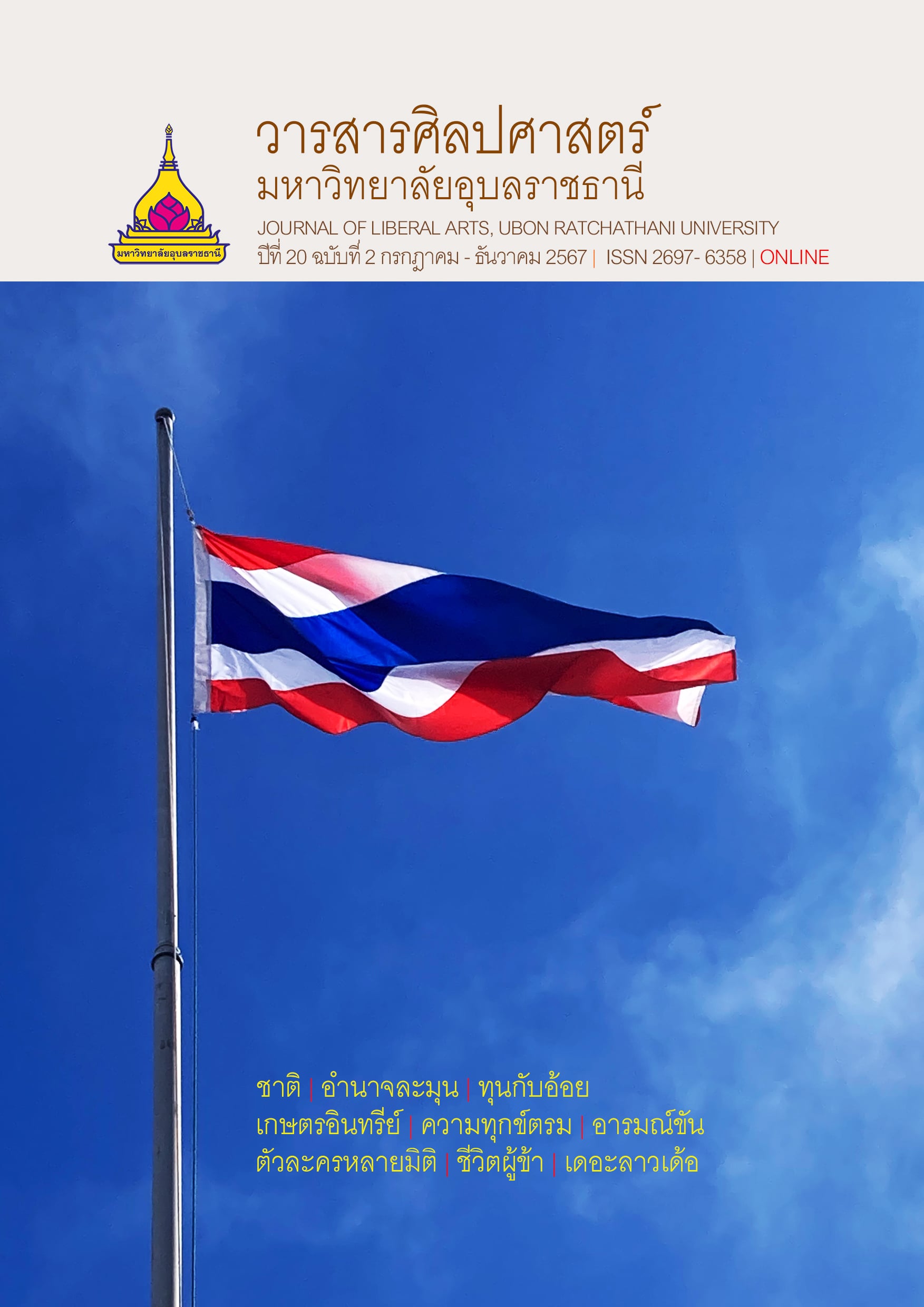“ชีวิตผู้ข้า” ตัวตนกับบริบททางประวัติศาสตร์ ในอัตชีวประวัติของมหาสิลา วีระวงส์
Main Article Content
บทคัดย่อ
บทความนี้ศึกษางานเขียนประเภทอัตชีวประวัติเรื่อง ชีวิตผู้ข้า อัตชีวประวัติ My Life Autobiography พุทธทำนาย 16 ข้อ และกลอนลำ แต่งในช่วงปี พ.ศ. 2487 ของมหาสิลา วีระวงส์ นักเขียน นักค้นคว้า และกวีคนสำคัญของลาว ซึ่งพิมพ์ในปี 2004 โดยใช้แนวคิดเรื่องการนำเสนอตัวตนหลายรูปแบบของผู้เขียนในงานเขียนประเภทอัตชีวประวัติของซิโดนี สมิธและจูเลีย วัตสันมาเป็นแนวทางในการศึกษา การศึกษานี้พบว่า มหาสิลาเลือกกล่าวถึงเรื่องราวความทรงจำและประสบการณ์ในอดีต เพื่อนำเสนอตัวตนที่สอดคล้องหรือไม่ขัดแย้งกับกระแสความคิดทางการเมืองในบริบทของความขัดแย้งระหว่างกลุ่มอุดมการณ์ทางการเมืองหลายฝ่ายที่ส่งผลกระทบต่อชีวิตและการทำงานของมหาสิลา ชีวิตผู้ข้า เสนอภาพตัวตนของมหาสิลาในสี่รูปแบบ ได้แก่ ตัวตนทางประวัติศาสตร์ ตัวตนในฐานะผู้เล่าเรื่อง ตัวตนที่ถูกบอกเล่า และตัวตนในอุดมคติ ตัวตนที่สำคัญและเป็นสิ่งที่มหาสิลามุ่งนำเสนอคือตัวตนในอุดมคติ ซึ่งได้แก่มหาสิลาในฐานะชายที่เติบโตขึ้นมาในชุมชนวัฒนธรรมลาวในภาคอีสานของสยาม มหาสิลาที่มีสำนึกรู้เกี่ยวกับสถานะของตนเองอันนำไปสู่ความเคลื่อนไหวต่อต้านอำนาจนำของไทย และท้ายที่สุดคือมหาสิลาที่อุทิศตนทำงานเพื่อฟื้นฟูวัฒนธรรมลาว ซึ่งทั้งหมดนี้ได้กลายเป็นคำอธิบายต่อบทบาทและสถานะของมหาสิลาในช่วงเวลาที่เขียนอัตชีวประวัติชิ้นนี้ขึ้นในทศวรรษที่ 1960 และ 1970
Downloads
Article Details

อนุญาตภายใต้เงื่อนไข Creative Commons Attribution-NonCommercial-NoDerivatives 4.0 International License.
เอกสารอ้างอิง
Bumrungwongsa, S. (2003). Demands for the Retrocession of Territories from the French and Their Subsequent Administration, 1940-1948. [in Thai]. Master’s thesis (History), Chulalongkorn University.
Department of Religious Affairs, Ministry of Education. (1982). History of Temples Throughout the Kingdom, Volume 1. [in Thai] Bangkok. Printing House of Religious Affairs Department.
Ivarsson, S. (2008). Creating Laos: The Making of a Lao Space between Siam and Indochina, 1860–1945. Copenhagen: NIAS Press.
Kummungkul, S. (1988). Education in Monthon Isan in the Reign of His Majesty King Chulalongkorn. [in Thai]. Master’s thesis (Education), Chulalongkorn University.
Lao Academy of Social Sciences. (2012). Dictionary of Lao Language. [in Lao] Vientiane: State Printing House.
Mattariganond, D. (2014). Historical Biographies in Laos During 1975-2010: The State of Knowledge. [in Thai]. Khon Kaen: Center for Research on Plurality in the Mekong Region (CERP), Khon Kaen University.
Murashima, E. (2015). Thailand and Indochina 1945-1950. Journal of Asia-Pacific Studies (Waseda University), 25, 137-176.
Polmuk, C. (2014). Life in a Time of Turmoil: Re-reading Colonialism and Nationalism in Autobiographies of Postwar Lao Intellectuals. Journal of Thai Language & Literature, 31 (2), 1-40.
Records Regarding the Suppression of the Wiang Chan Insurrection. (1926). [in Thai]. Bangkok: Sophon Pipathanakara Printing House.
Smith, S. & Watson, J. (2010). Reading Autobiography: A Guide for Interpreting Life Narratives. Minneapolis, MN: University of Minnesota Press.
Soontravanich, C. (2006). “Maha Sila Viravong’s Phongsavadan Lao.” In Wongyannava, T., editor. Chakkrawan Witthaya: The Articles in Honor of Nidhi Eoseewong. [in Thai]. (p. 2-37). Bangkok: Matichon.
Thiphakorawong (Kham Bunnag), Chaophraya. (1934). Royal Chronicle of the Kingdom of Rattanakosin: Third Reign. [in Thai]. n.p.: Sri Hongsa Printing House.
Viravong, S. (1960). Dictionary of Lao Language of the Literature Committee Buddhist Era 2503. [in Lao] Vientiane: Printing House of Textbook Division of the Ministry of Education.
Viravong, S. (2004). Sivid Phukha My Life Autobiography, Buddhist Prediction and Poems from the ‘40s. [in Lao]. Vientiane: Manthaturad.
Wyatt, D. K. (2013). Thailand: A Short History. [in Thai]. Bangkok: The Foundation for the Promotion of Social Sciences and Humanities Textbooks Projects.


